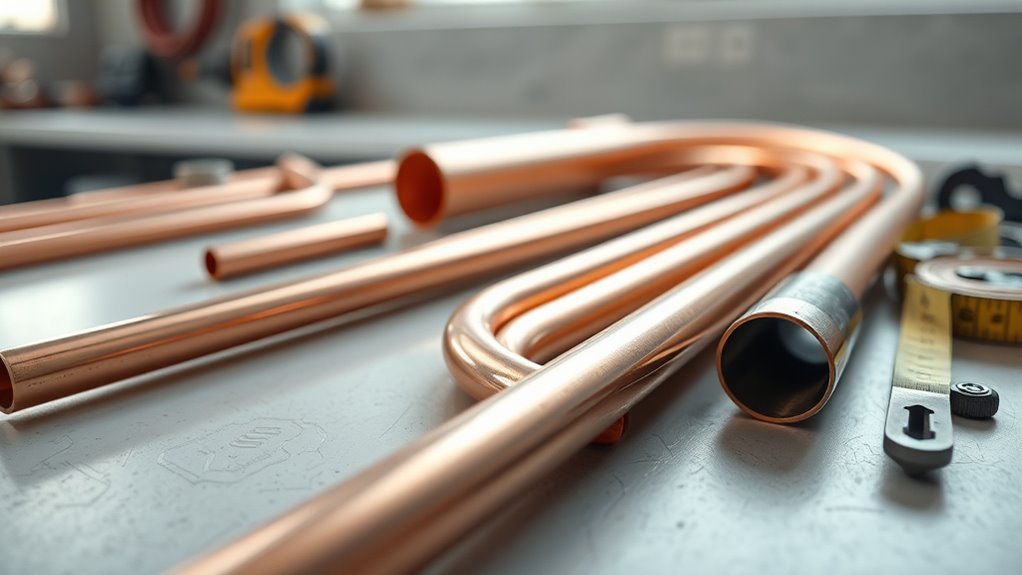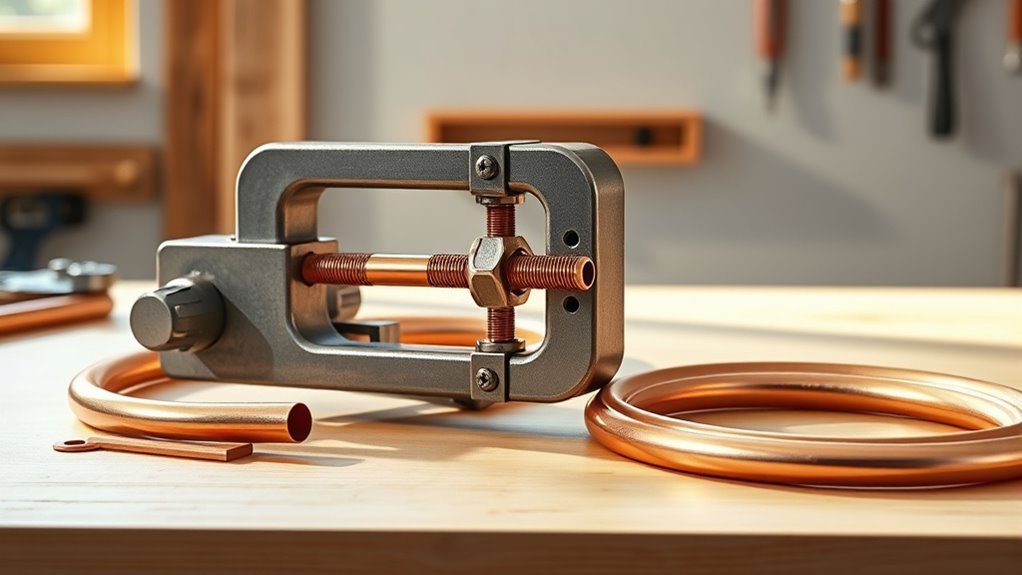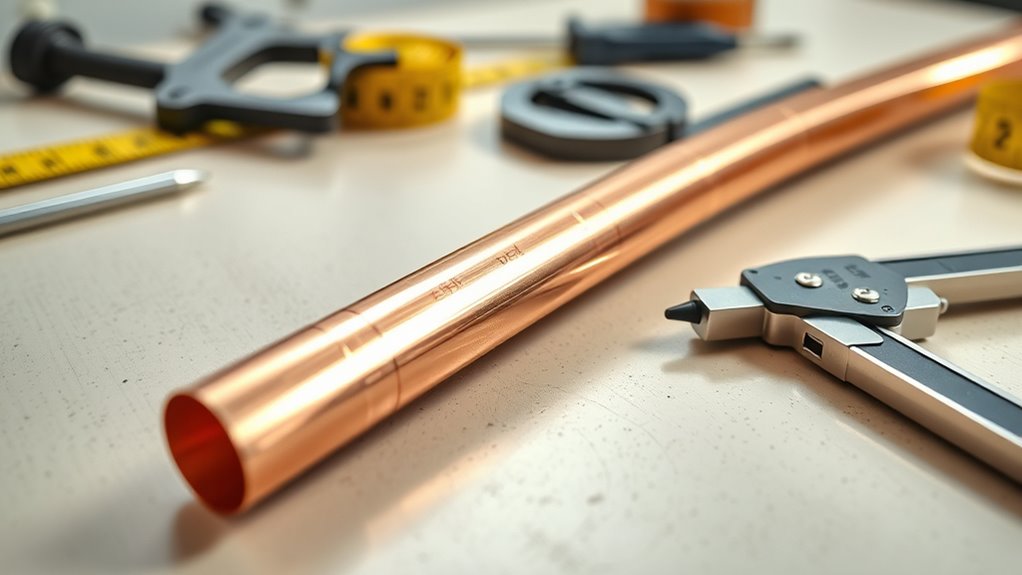To bend copper pipe without kinking, follow these key steps:
- Use a Copper Pipe Bender: This tool is designed to create smooth, kink-free bends.
- Apply Gentle, Even Pressure: Ensure that you bend the pipe gradually to avoid any kinks.
- Support the Pipe: Use supports to stabilize the pipe while bending.
- Lubrication: Apply lubricant to reduce friction, making the bending process smoother.
- Measure and Mark Accurately: Precise measurements are crucial to maintain the integrity of the bend.
By adhering to these techniques, you can achieve professional-quality bends in your copper piping.
Understanding Copper Pipe Properties

Copper pipe is an essential component in plumbing and heating systems, and understanding its properties is crucial for effective use. Here are key points to consider:
- Malleability: Copper’s high malleability allows it to be easily shaped, which is important for creating bends without breaking the pipe.
- Corrosion Resistance: Copper pipes offer excellent resistance to corrosion, ensuring longevity in both hot and cold water applications.
- Thermal Conductivity: Copper’s superior thermal conductivity makes it ideal for transferring heat efficiently.
- Types and Thicknesses: Standard copper pipes come in various grades, with Type K, L, and M being the most common. Each type has different wall thicknesses, impacting strength and flexibility.
- Expansion and Contraction: Copper pipes expand and contract with temperature changes, so it’s vital to account for this during installation to avoid leaks or damage.
Importance of Proper Bending Techniques
Proper Bending Techniques for Copper Pipes: A Key to Efficient Plumbing
When working with copper pipes, using the right bending techniques is crucial for maintaining a reliable plumbing system.
Here’s how proper bending impacts your plumbing setup:
- Avoiding Kinks: Prevents leaks and system failures.
- Using Correct Angles: Ensures smooth water flow.
- Maintaining Radius: Preserves the pipe’s structural strength.
- Choosing Right Tools: Enhances bending accuracy.
Tools Required for Bending Copper Pipe
To bend copper pipes effectively, you’ll need specific tools to ensure clean and accurate bends. Here’s a concise list of the essential tools:
- Copper Pipe Bender: This is the primary tool for creating smooth bends without kinking. Choose between manual or hydraulic models based on your bending needs.
- Pipe Cutter: A good cutter is essential for preparing the copper pipes, ensuring clean, straight edges before bending.
- Measuring Tape: Accurate measurements are crucial. Use a measuring tape to mark where you need to bend the pipe.
- Form or Jig: For more intricate bends, a form or jig can help guide the pipe into the desired shape.
- Safety Gear: Always wear gloves and safety goggles to protect yourself during the process.
Having these tools will make your copper pipe bending project efficient and safe.
Choosing the Right Size of Copper Pipe
Choosing the right size of copper pipe is crucial for optimal plumbing and heating system performance. The pipe diameter influences flow rates and pressure, making it essential to align the size with your project’s specific needs.
Common sizes include 1/2-inch, 3/4-inch, and 1-inch, each suited for different applications. When selecting a size, consider the system type, run length, and number of fittings.
Be aware of local building codes that may restrict pipe sizes for certain installations. Proper sizing ensures efficient operation and reduces the risk of leaks and pressure loss, leading to a reliable system.
Types of Bending Tools Available
When bending copper pipe, selecting the right tool is crucial for achieving desired results.
For smaller projects, manual bending tools offer ease and control.
For larger jobs, hydraulic bending machines provide the necessary power and precision.
Knowing the strengths of each tool helps you choose the best fit for your specific bending needs.
Manual Bending Tools
If you’re looking to shape copper pipes with precision, manual bending tools are essential. Here’s a quick overview of the most effective options:
- Pipe Bender: This tool features a curved die that guides the pipe, ensuring smooth curves without kinking.
- Lever-Action Bender: Utilizes a lever mechanism for greater control over the bending angle, making it ideal for more intricate bends.
- Adjustable Bending Tools: These versatile tools can accommodate various pipe sizes and bending angles, perfect for diverse projects.
- Hand-Held Benders: Lightweight and portable, these are great for smaller tasks and on-the-go adjustments.
Each of these tools is designed to help you achieve accurate bends while preserving the integrity of the copper pipe.
Choose the one that best fits your specific needs for efficient results.
Hydraulic Bending Machines
For precise bending of copper pipes, hydraulic bending machines are essential tools that outperform manual alternatives. They leverage hydraulic pressure to achieve accurate bends without kinking, making them perfect for professional use.
Here’s a quick overview of the types of hydraulic bending machines:
| Type | Advantages | Ideal Use |
|---|---|---|
| Portable Hydraulic | Lightweight and transportable | On-site applications |
| Stationary Hydraulic | High precision and robust power | Mass production |
| CNC Hydraulic | Fully automated bending | Complex designs |
Choose the right hydraulic bending machine based on your project needs to ensure efficiency and quality.
Manual Bending Techniques
Manual bending techniques are essential for shaping copper pipe accurately without powered tools.
For those seeking effective methods, hand bending requires skill and precision, while a pipe former can help achieve even more accurate bends and minimize kinking.
Mastering these techniques is crucial for successful plumbing and crafting projects.
Hand Bending Methods
Bending copper pipe by hand can be done effectively with a few key techniques.
To achieve smooth and precise curves, you can gradually apply pressure along the pipe with your hands, making sure to work slowly and avoid kinking.
Alternatively, wrapping the pipe around a sturdy object, like a post or large cylinder, allows for a controlled bend.
Using a bending spring can also help maintain the shape and prevent deformation.
Be sure to measure and mark the bend location accurately to ensure it meets your project specifications.
These methods will help you achieve professional results in your copper pipe bending tasks.
Using a Pipe Former
Using a pipe former makes bending copper pipes easier and more precise. This tool features a sturdy frame and interchangeable bending dies for different pipe sizes.
Simply insert the pipe, align it with the appropriate die, and apply even pressure to achieve the desired angle without kinking. This method is ideal for complex plumbing systems, reducing errors common in manual bending.
Using a Pipe Bender

If you’re looking for an efficient way to bend copper pipe, a pipe bender is your best option. This tool ensures precise bends without kinking, making it ideal for both beginners and experienced users.
Here are the key benefits of using a pipe bender:
- Precision: Achieve accurate bends at the angles you need.
- Ease of Use: Streamlined process that anyone can master.
- Durability: Built to last through repeated use.
- Versatility: Works with various copper pipe sizes for different projects.
Using a pipe bender guarantees quality results and simplifies your plumbing tasks.
Heat Bending Copper Pipe
Heat bending copper pipe is an effective technique for shaping the metal by softening it through various heating methods. To achieve successful results while ensuring safety, follow these key steps:
- Choose the Right Heating Method: Common methods include using a torch, heat gun, or oven. Select one based on the pipe size and your experience level.
- Safety Precautions: Always wear protective gear, including gloves and goggles. Work in a well-ventilated area to avoid inhaling fumes.
- Heat Evenly: Apply heat uniformly around the pipe to prevent uneven bending or damage.
- Bend Carefully: Once the pipe is sufficiently heated, gently bend it to the desired angle. Use a bending tool for precision.
- Cool Down: Allow the pipe to cool slowly to retain its shape and avoid cracking.
Heating Methods Overview
To effectively bend copper pipe, applying heat is essential to soften the material. Here are some heating methods tailored to your project needs:
- Propane Torch: Ideal for quick and localized bends.
- Heat Blanket: Best for larger bends, providing even heat distribution.
- Oven Method: Perfect for small pipes, ensuring uniform heating without overheating.
- Boiling Water: A safe option for smaller pipes, though less effective for larger diameters.
Selecting the appropriate method helps achieve smooth bends while preventing kinks in the pipe.
Safety Precautions Required
Before bending copper pipe, it’s crucial to prioritize safety. Here are key precautions to ensure a secure working environment and minimize risks:
| Safety Precaution | Description |
|---|---|
| Wear Protective Gear | Use gloves, goggles, and a face shield to protect against burns and flying debris. |
| Ensure Proper Ventilation | Work in a well-ventilated area to avoid inhaling harmful fumes from heated materials. |
| Keep Flammable Materials Away | Maintain a safe distance from flammable substances to prevent fire hazards during heating. |
Avoiding Kinks: Best Practices
To ensure copper pipe remains kink-free during bending, follow these best practices:
- Use a Proper Pipe Bender: Choose a bender specifically designed for copper pipes to ensure smooth bends.
- Support the Pipe: Properly support the pipe to avoid sharp angle bends that can cause kinks.
- Apply Lubricant: Use bending lubricant to reduce friction and prevent damage.
- Bend Slowly: Execute slow and steady bends, avoiding sudden movements that could lead to kinks.
Marking the Bend Points

To achieve precise bends in copper pipes, it’s crucial to mark the bend points accurately. This ensures that your bends are consistent and minimizes the risk of kinking. Here’s how to do it effectively:
- Measure the Distance: Use a measuring tape to determine how far from one end of the pipe you want to make the bend.
- Make Clear Markings: Use a fine-tip marker or pencil to make visible marks at the designated bend locations.
Essential Tools for Marking Bend Points
| Tool | Purpose | Tips |
|---|---|---|
| Measuring Tape | Measure distances | Ensure it’s straight |
| Marker | Mark bend points | Use a fine tip for clarity |
| Level | Check alignment | Keep pipe horizontal |
| Pipe Bender | Create bends | Follow the manufacturer’s guide |
| Straight Edge | Guide for marking | Confirm it’s level |
Maintaining Consistent Pressure While Bending
When bending copper pipe, it’s crucial to maintain consistent pressure for smooth, uniform curves.
Using a pipe bender ensures even force throughout the bending process.
Additionally, applying heat can help achieve smoother bends and minimize the risk of kinks.
This approach directly addresses your need for effective copper pipe bending techniques.
Use a Pipe Bender
To effectively use a pipe bender and achieve smooth, kink-free bends in copper pipes, follow these essential tips:
- Grip the Handle Firmly: A strong grip ensures even pressure during bending.
- Use Markings: Refer to the bender’s markings for guidance on the required angle and pressure.
- Bend Slowly: Gradual bending allows for better control and reduces the risk of deforming the pipe.
- Check Alignment Frequently: Regularly inspect the pipe’s alignment to ensure it maintains the desired curve.
Employ Heat Techniques
Applying heat to copper pipes is an effective method for achieving smooth bends without kinking. To do this, use a torch or heat gun to warm the section of the pipe you want to bend. This softens the metal, making it easier to shape.
Maintain consistent pressure while bending to ensure a gradual curve and prevent deformation. However, be cautious not to overheat the pipe, as this can cause damage.
Testing the Bend for Accuracy
After bending a copper pipe, it’s essential to test the bend for accuracy to ensure it fits properly in its intended application.
Here are quick methods to verify the accuracy of your bend:
- Measure the Distance: Use a measuring tape to check the distance between bends against the specifications.
- Check Alignment: Hold the pipe up to the installation area to confirm it aligns correctly.
- Inspect for Kinks: Look for any visible kinks or deformations in the bend.
- Water Flow Test: Run water through the pipe to check for leaks or blockages.
Following these steps will help ensure your bent copper pipe performs as needed.
Common Mistakes to Avoid
When bending copper pipe, be aware of these common pitfalls to ensure a successful outcome:
- Excessive Force: Applying too much force can cause kinking. Use gentle, even pressure for smooth bends.
- Lack of Lubrication: Not lubricating the pipe increases friction, leading to uneven bends. Always apply a suitable lubricant.
- Incorrect Bending Tool: Using the wrong size of bending tool can damage the pipe. Ensure you have the right tool for the job.
- Inaccurate Measurements: Failing to measure and mark bending points correctly can result in improper angles. Always double-check your measurements.
- Skipping Practice: Neglecting to practice on scrap pieces can lead to mistakes on your final project. Take the time to hone your skills first.
- Safety Gear: Not wearing proper safety gear can result in accidents. Always prioritize safety during the bending process.
Repairing Kinks in Copper Pipe
Kinks in copper pipes can disrupt plumbing functionality and lead to leaks. Here are effective methods to repair kinks:
- Heat Application: Use a propane torch to gently heat the kinked area, softening the metal for easier reshaping.
- Pipe Expansion Tool: Employ a pipe expansion tool to carefully expand the damaged section without causing further damage.
- Internal Pipe Support: Insert a flexible mandrel or dowel into the pipe to provide support while reshaping the kink.
- Replacement: If the kink is too severe, cut out the affected section and replace it with a new piece of pipe.
These methods can help restore proper flow and maintain your plumbing system’s integrity.
Safety Precautions While Bending Copper Pipe
When bending copper pipe, it’s crucial to prioritize safety. Always wear personal protective equipment (PPE) like safety goggles and gloves to protect against potential injuries.
Ensure your workspace is well-ventilated if you’re using tools that emit heat or fumes. Keep your area clutter-free to reduce the risk of tripping.
Follow the manufacturer’s instructions closely when using bending tools to prevent accidents. Before bending, inspect the copper pipe for any defects to avoid breakage.
Using the correct bending technique will enhance both safety and the quality of your bends.
Conclusion
Bending copper pipe without kinking requires the right techniques and tools. Here are some essential steps to achieve clean bends:
- Use a Pipe Bender: A pipe bender is specifically designed to create smooth curves without damaging the pipe. Choose one that fits the diameter of your copper pipe.
- Heat the Pipe: For softer bends, gently heat the copper with a torch. This makes the metal more pliable and reduces the risk of kinking.
- Support the Pipe: Ensure the pipe is properly supported at both ends. This prevents excessive pressure that could lead to kinks.
- Bend Gradually: Apply steady pressure while bending. Avoid sudden movements, as they can cause the pipe to kink.
- Use a Filler: For tighter bends, consider using a filler (like sand) inside the pipe to maintain its shape during the bending process.
By following these steps, you can successfully bend copper pipe without kinking, achieving both functional and aesthetic results.

I’m Allen Kim, the chief editor of plumbinginto. I am a mid level plumber and assign to an local firm over 4 years of experience. During the working period, most of my experience is related to the house plumbing. I learned about the thing, when working with most experienced people in this sector, one must be as good as the inspector or better with knowledge of the project as well as the practical aspects of plumbing industry.